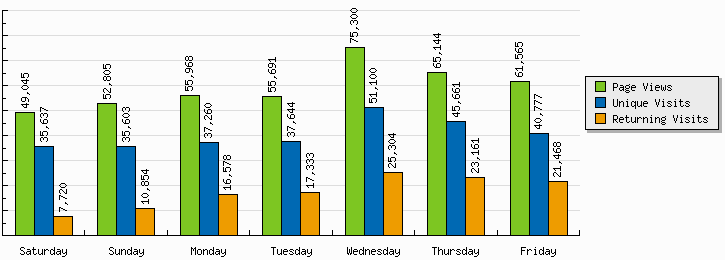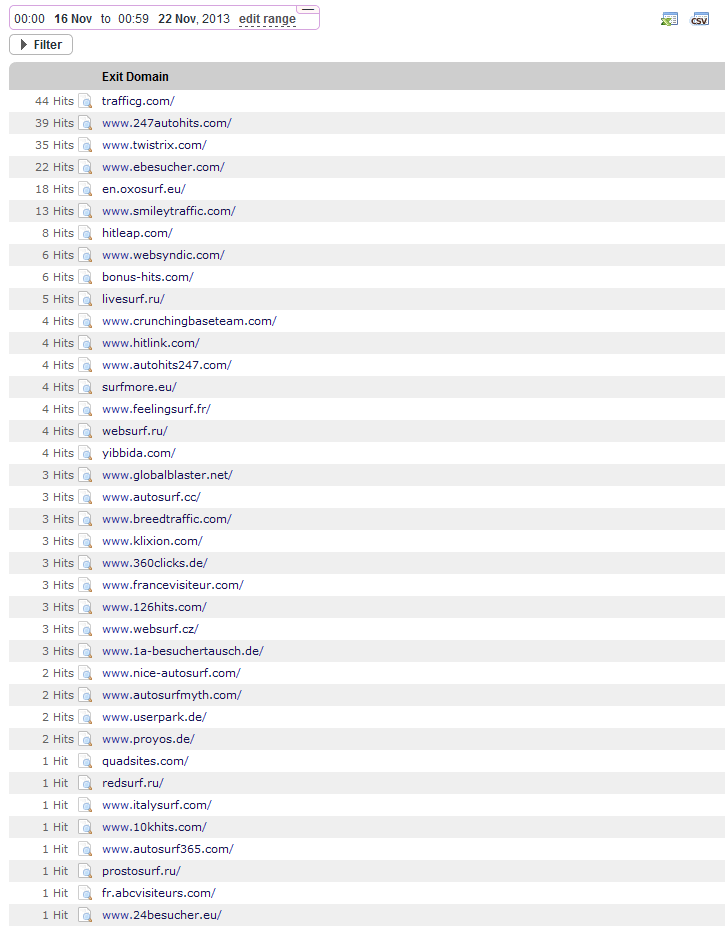You’ve probably heard people saying that autosurfs don’t work, that the traffic they send is useless, and so on. I’m going to try and convince you otherwise with this post, and I have some stats to back my words up.
I’ve run StatCounter on this page (which I promote heavily in autosurf exchanges) for a week. Here are my hit statistics:

According to StatCounter, the page in question has received 415,518 views, 283,682 (or 68.27%) of which were unique visitors. Now, StatCounter is pretty nifty as it not only counts visits, but tracks exit links (or clickouts) as well. This allows you to see which links are getting clicked the most, and calculate the overall CTR of your page if you wish. Except, since autosurfs don’t work, I won’t be getting any clickouts… Right?
Let the data speak for itself:

I’ve used StatCounter’s “Group by Domain” setting to make things more simple, which is why you see only the domain and not the actual link. Excluding TrafficG and HitLink, which are banner clicks, I’ve received 219 clickouts on my referral links, so the CTR is about 0.0527%. This is rather shocking as I get similar click-trough rates (as tracked by Trck.me) on some well-designed splash pages that I promote in manual TEs! (Many splashes do get better CTRs, but there are some which only get 0.05% and lower).
Now, there are some caveats that you should be aware of:
- StatCounter needs JavaScript to track both visits and clickouts. Many autosurfers use plugins like NoScript – which disables JavaScript – for increased safety and stability. This means that the actual visitor count is probably significantly higher. Then again, so is the clickout count, so it all balances out.
- The unexpectedly high click-through rate can probably be explained by the same person clicking multiple links from the list. I might do the same kind of testing with one of my smaller splash pages to see if the CTR is lower.
- StatCounter doesn’t track clicks to the same domain, so people clicking the link leading to the main site don’t register. I didn’t have SC installed on the site itself, either. This means that the actual CTR is even higher!
These stats clearly demonstrate that autosurfs do work, even if your click-through rate will be on average much lower than in manual traffic exchanges (no surprise there). On the bright side, you don’t need to be at your computer to autosurf, and you can easily run as many as 20 surfbars at once. It’s simply a matter of quantity: if your click-through rate is low, you just have to send so much traffic to your page that it won’t matter.
Autosurf exchanges still get a lot of bad rep, perhaps because of the so-called “investment autosurfs” which were all the rage a few years ago. Absolute majority of those sites were Ponzi schemes and scams, so it’s not so surprising that many people react negatively to the very word. However, in my eyes legit autosurf exchanges aren’t much different from safelists or manual TEs. Sure, less people will actually see your site, and you will get less clicks per visit, but no one’s trying to trick you or tell you otherwise. That’s why I find it somewhat hypocritical when people who praise manual TEs (one type of incentivized traffic) criticize autosurfs (another type of incentivized traffic).
If you doubt my results, you can test this yourself. StatCounter is free and simple to use, and this list should come in handy if you’re looking for good autosurfs to use. But make sure to promote in as many different sites as possible: just like with manual TEs, different autosurfs can give you vastly different results.